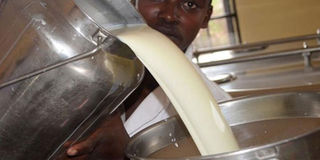Prime
Solar powered milk coolers cut losses

Dairy farmers are encouraged to invest in solar powered milk coolers. Photo | File
What you need to know:
- Second, higher production levels can be obtained as reliable cooling facilities can enable many farmers to milk their cows twice a day, thereby generating additional income.
More than three billion people consume milk and its products throughout the world, and the number is growing.
Experts note that more than 750 million people live in dairy farming households, particularly in emerging economies with most dairy-farmers operating at a small-scale level.
The global milk yield is 11 litres per farm per day, produced by an average number of two cows. Hence, the development of the small-scale dairy sector could be a powerful tool for reducing poverty and creating wealth in the developing world.
The milk value chain mainly goes through four steps: milking, transportation to milk collection centres, processing, and retail.
During the milking process, it is fundamental to fulfil the adequate hygiene standards that help to avoid bacterial infection of the milk.
In many countries, milk entering the formal sector is first chilled at village collection centres.
However, some dairies and cooperatives control the quality of the collected milk and reject milk that is spoilt.
How you can maintain quality
In Uganda, there are a number of initiatives by various stakeholders ensuring that farmers maintain proper hygiene of milk during the value chain. One of the ways is through using the right equipment and energy solution to chill the milk.
One such case is where Heifer International is introducing solar chilling technology to small scale farmers to ensure their milk is kept cool and fresh for consumption.
Explaining the importance of solar energy used in chilling milk, the programme manager at Heifer International, Mr John Senyonga, notes that enhancing milk handling practices and raising awareness of milk-borne diseases can help reduce health risks.
He contends that introducing cooling facilities right after milking can reduce bacterial growth considerably.
Innovation
Different technologies have been developed in order to provide an uninterrupted cooling chain until reaching the milk collection centres, reducing the amount of milk that is rejected, increasing farmers’ incomes and improving food security.
Further when cooling devices are run on renewable energy, they can be used off-grid and are climate-friendly, which eliminates additional costs from electricity supply.
As initial upfront capital costs are often the main obstacles for adopting these innovative approaches, different financing options have been developed, enabling easy access to smallholder farmers.
Increasing the energy efficiency in the dairy value chain implies using also its by-products. Cattle manure can be used for biogas production, which can generate heat for cooking, heating, band electricity – which in turn can power cooling systems and hence prevent spoilage of milk.
In low-income countries, most of the milk is produced by smallholder farmers, as it is one of the few commodities that can be produced even by the landless. The surplus milk can be sold on the local markets.
Due to its composition, milk at ambient temperature provides an ideal medium for bacterial growth, which can be a vector for infectious diseases, being hazardous for human consumption. Cooling milk slows down bacterial growth, reducing spoilage, increasing farmers’ income and providing a certain safety for the milk consumer.
Solar powered milk chilling
Senyonga explains that his team is now encouraging dairy farmers to embrace solar power cooling systems for chilling their milk.
A demonstration is being done on two farms in partnership with New Sum Road company dealers in solar power equipment who have installed the equipment for the farmers to see how it operates. The system comprises a remote monitoring system which is connected to the Internet and users can connect the same to the computer to monitor the cooling system and other functions.
In general, about 369,000 small holder farmers are involved in this initiative. They will be able to take their milk to the installed chilling plant to avoid spoilage.
The solar milk cooling system uses solar energy for ice production. The produced ice is used to cool the milk by putting it into an ice-compartment of an insulated milk can.
This system allows lower temperatures during transportation and overnight storage, increasing the farms production and income
This kind of cooling technology can significantly improve milk quality and add value along the milk value chain.
Operation
The solar-powered cooler is an ice based system which consists of solar panels linked to a control panel and batteries for the freezer with an ice maker.
It is ideal for small-holder farmers who face regular milk cooling challenges and are not connected to their country’s national electricity grid.
Ice is first prepared with solar power and this ice is filled into an extra vessel in the middle of the specially insulated churns. This enables milk to be cooled up to 12 hours, preventing formation of germs.
The successful storage of ice blocks, which are used to keep the milk cooler for longer, enables the system to run in areas which have low solar radiation and high ambient temperatures.
Benefits
Indeed, there are multiple benefits to being able to keep milk cooler for longer. First, cooling can help retain milk quality and ensure premium prices are obtained at the market outlet.
Second, higher production levels can be obtained as reliable cooling facilities can enable many farmers to milk their cows twice a day, thereby generating additional income.
Milk processors are able to charge a premium price for better tasting dairy products that are chilled from farm to factory, thereby earning better income.’




